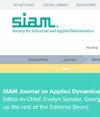论最优控制技术在混沌系统时间平均敏感性分析阴影法中的应用
IF 1.8
4区 数学
Q2 MATHEMATICS, APPLIED
引用次数: 0
摘要
SIAM 应用动力系统期刊》,第 23 卷第 1 期,第 505-552 页,2024 年 3 月。 摘要。由于线性化方程的不稳定特性,传统的灵敏度分析方法对混沌系统无效。为了克服这些问题,文献中提出了两种方法,一种是阴影法,这种方法会导致最小化问题;另一种是数值粘性法,即在线性化方程中加入阻尼项以抑制不稳定性。阴影法计算成本高,但能得到精确的敏感度,而数值粘度法能得到精度较低的敏感度,但计算成本大大降低。然而,目前还不完全清楚这两种方法产生的解之间如何比较。在这项工作中,我们旨在通过引入一个控制项来弥补这一差距,该控制项是利用最优控制理论技术找到的,可防止线性化方程的解呈指数增长。我们将这种方法称为最优控制阴影法。我们研究了这种新方法在 Lorenz 和 Kuramoto-Sivashinsky 系统上的计算方面和性能,并将其性能与简单的数值粘度方案进行了比较。我们发现,所提方法生成的切线解与阴影法生成的切线解相似,表明最优控制试图稳定不稳定的阴影方向。此外,对于空间扩展系统,我们研究了切线方程的能量预算,结果表明通过最优控制问题求解找到的控制项仅作用于切线能量产生主导耗散的长度尺度,而数值粘度方法不一定是这种情况。本文章由计算机程序翻译,如有差异,请以英文原文为准。
On the Application of Optimal Control Techniques to the Shadowing Approach for Time Averaged Sensitivity Analysis of Chaotic Systems
SIAM Journal on Applied Dynamical Systems, Volume 23, Issue 1, Page 505-552, March 2024.
Abstract. Traditional sensitivity analysis methods fail for chaotic systems due to the unstable characteristics of the linearized equations. To overcome these issues two methods have been developed in the literature, one being the shadowing approach, which results in a minimization problem, and the other being numerical viscosity, where a damping term is added to the linearized equations to suppress the instability. The shadowing approach is computationally expensive but produces accurate sensitivities, while numerical viscosity can produce less accurate sensitivities but with significantly reduced computational cost. However, it is not fully clear how the solutions generated by these two approaches compare to each other. In this work we aim to bridge this gap by introducing a control term, found with optimal control theory techniques, to prevent the exponential growth of solution of the linearized equations. We will refer to this method as optimal control shadowing. We investigate the computational aspects and performance of this new method on the Lorenz and Kuramoto–Sivashinsky systems and compare its performance with simple numerical viscosity schemes. We show that the tangent solution generated by the proposed approach is similar to that generated by shadowing methods, suggesting that optimal control attempts to stabilize the unstable shadowing direction. Further, for the spatially extended system, we examine the energy budget of the tangent equation and show that the control term found via the solution of the optimal control problem acts only at length scales where production of tangent energy dominates dissipation, which is not necessarily the case for the numerical viscosity methods.
Abstract. Traditional sensitivity analysis methods fail for chaotic systems due to the unstable characteristics of the linearized equations. To overcome these issues two methods have been developed in the literature, one being the shadowing approach, which results in a minimization problem, and the other being numerical viscosity, where a damping term is added to the linearized equations to suppress the instability. The shadowing approach is computationally expensive but produces accurate sensitivities, while numerical viscosity can produce less accurate sensitivities but with significantly reduced computational cost. However, it is not fully clear how the solutions generated by these two approaches compare to each other. In this work we aim to bridge this gap by introducing a control term, found with optimal control theory techniques, to prevent the exponential growth of solution of the linearized equations. We will refer to this method as optimal control shadowing. We investigate the computational aspects and performance of this new method on the Lorenz and Kuramoto–Sivashinsky systems and compare its performance with simple numerical viscosity schemes. We show that the tangent solution generated by the proposed approach is similar to that generated by shadowing methods, suggesting that optimal control attempts to stabilize the unstable shadowing direction. Further, for the spatially extended system, we examine the energy budget of the tangent equation and show that the control term found via the solution of the optimal control problem acts only at length scales where production of tangent energy dominates dissipation, which is not necessarily the case for the numerical viscosity methods.
求助全文
通过发布文献求助,成功后即可免费获取论文全文。
去求助
来源期刊

SIAM Journal on Applied Dynamical Systems
物理-物理:数学物理
CiteScore
3.60
自引率
4.80%
发文量
74
审稿时长
6 months
期刊介绍:
SIAM Journal on Applied Dynamical Systems (SIADS) publishes research articles on the mathematical analysis and modeling of dynamical systems and its application to the physical, engineering, life, and social sciences. SIADS is published in electronic format only.
 求助内容:
求助内容: 应助结果提醒方式:
应助结果提醒方式:


